-
Countries
-
Data and Analysis
-
Special Focus
-
Crisis Responses
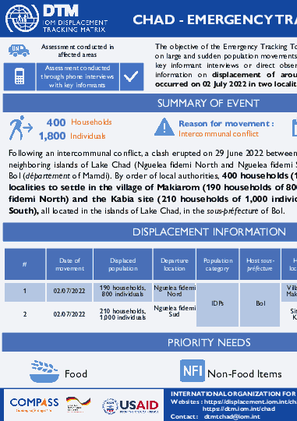
Contact
DTM Chad, dtmtchad@iom.int
Language
English
Location
Chad
Snapshot Date
Jul 05 2022
Activity
- Mobility Tracking
- Event Tracking
Following an intercommunal conflict, a clash erupted on 29 June 2022 between two communities living in two neighboring islands of Lake Chad (Nguelea fidemi North and Nguelea fidemi South) in the sous-préfecture of Bol (département of Mamdi). By order of local authorities, 400 households (1,800 individuals) left these localities to settle in the village of Makiarom (190 households of 800 individuals from Nguelea fidemi North) and the Kabia site (210 households of 1,000 individuals from Nguelea fidemi South), all located in the islands of Lake Chad, in the sous-préfecture of Bol
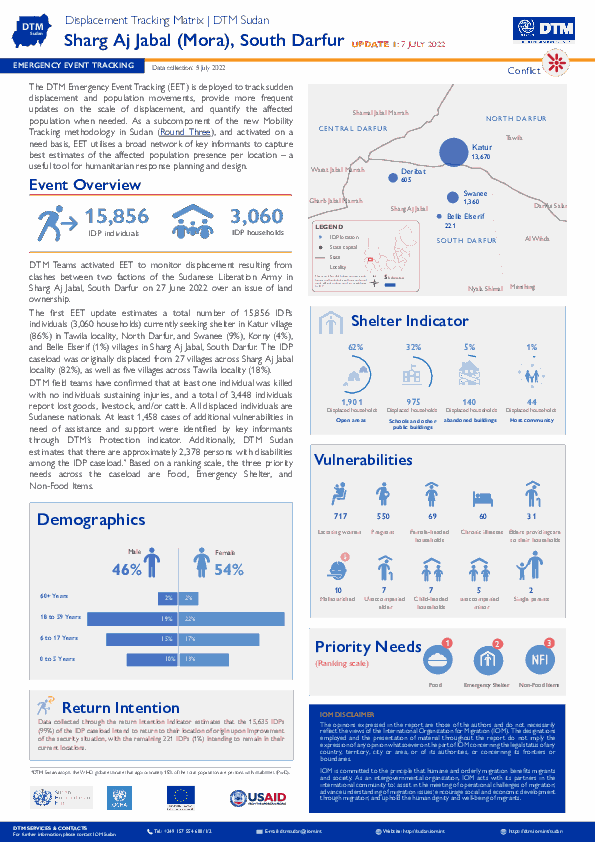
Contact
DTM Sudan; dtmsudan@iom.int
Language
English
Location
Sudan
Snapshot Date
Jul 05 2022
Activity
- Mobility Tracking
- Event Tracking
The DTM Emergency Event Tracking (EET) is deployed to track sudden displacement and population movements, provide more frequent updates on the scale of displacement, and quantify the affected population when needed. As a subcomponent of the new Mobility Tracking methodology in Sudan (Round Three), and activated on a need basis, EET utilises a broad network of key informants to capture best estimates of the affected population presence per location – a useful tool for humanitarian response planning and design.
Contact
DTMDRC@iom.int
Location
Democratic Republic of the Congo
Activity
- Mobility Tracking
- Baseline Assessment
Period Covered
Apr 06 2022 -May 05 2022
A baseline assessment is a sub-component of mobility tracking. It aims to collect data on IDP, migrant or returnee population presence in a defined administrative area of the country.
Population Groups
Survey Methodology
Unit of Analysis Or Observation
Type of Survey or Assessment
Keywords
Geographical Scope
Administrative boundaries with available data
The current dataset covers the following administrative boundaries

Contact
DTM Europe, DTMMediterranean@iom.int
Language
English
Location
Poland
Period Covered
Mar 04 2022
Apr 11 2022
Activity
- Survey
- Community Perception
Since 24 February 2022, over 2.7 million Ukrainian refugees and third country nationals (TCNs) have entered Poland as a result of the war in Ukraine. This report is based on a displacement patterns, needs, and intentions survey launched by IOM's DTM. Surveys are conducted face-to-face by trained enumerators of DTM at border crossing points and reception centers in Rzeszów, in the Podkarpackie Voivodeship, with Ukrainian refugees and TCNs fleeing from Ukraine because of the war. Data is collected and stored through Kobo, a mobile application. This report presents the findings of data collected from 4 March to 11 April 2022.
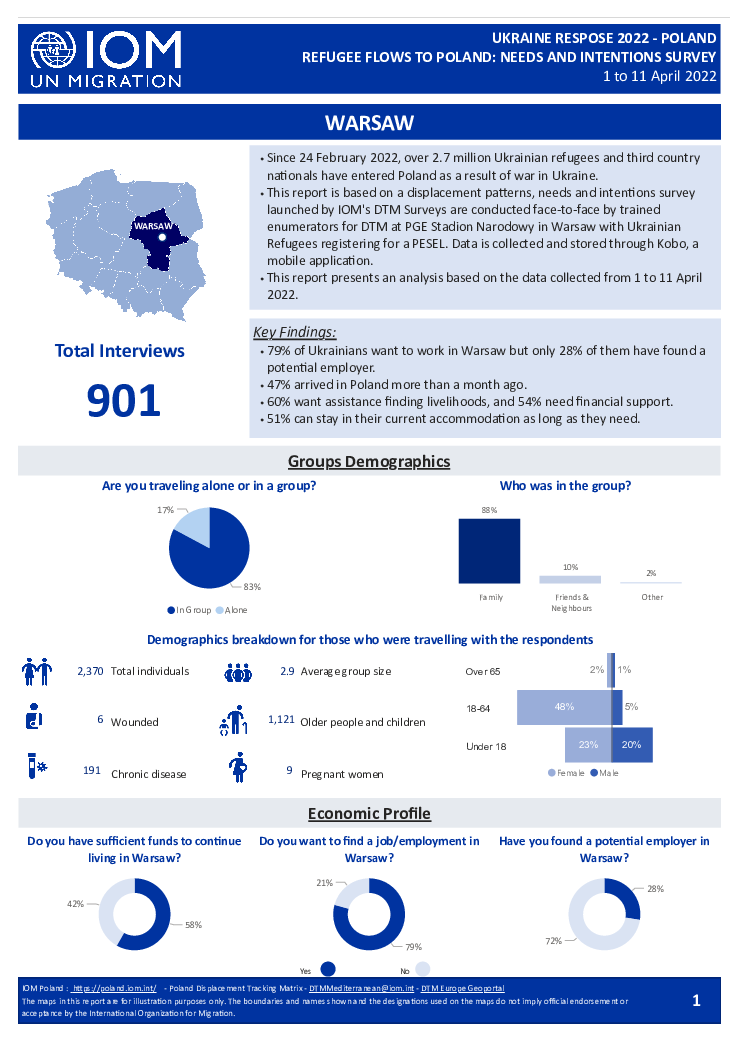
Contact
DTM Europe, DTMMediterranean@iom.int
Language
English
Location
Poland
Period Covered
Apr 01 2022
Apr 11 2022
Activity
- Survey
- Community Perception
Since 24 February 2022, over 2.7 million Ukrainian refugees and third country nationals have entered Poland as a result of war in Ukraine. This report is based on a displacement patterns, needs and intentions survey launched by IOM's DTM Surveys are conducted face-to-face by trained enumerators for DTM at PGE Stadion Narodowy in Warsaw with Ukrainian Refugees registering for a PESEL. Data is collected and stored through Kobo, a mobile application. This report presents an analysis based on the data collected from 1 to 11 April 2022.
Contact
iomyemendtm@iom.int
Location
Yemen
Activity
- Flow Monitoring
Period Covered
Jun 01 2022 -Jun 30 2022
In June 2022, IOM Yemen DTM recorded 3,174 migrants entering Yemen, similar to 3,228 in May 2022. In both Shabwah and Lahj DTM has registered a decrease in arrivals since February 2022 although a slight increase has been observed in Shabwah this June compared to May. The overall decrease is in part linked to seasonal weather conditions as well as an increase in border patrols from the Djibouti side, especially near Lahj meaning smaller boats with fewer migrants made their way to Yemen. The slight increase in Shabwah can be attributed to the urgent need to send as much as possible of migrants from Bosasso, Somalia to Shabwah, Yemen because the windy season is approaching and it will be difficult for migrants to travel at that period.
Due to the deteriorating humanitarian crisis in Yemen and the challenges in moving towards KSA, many migrants opted to return to the Horn of Africa. Moreover, DTM recorded 5,895 Yemeni returns from KSA during the month of June 2022, compared to 5,440 in May 2022.
Between 1 January and 30 June 2022, DTM recorded 31,266 migrants and 35,285 Yemeni migrant returnees to Yemen.
The migrant caseload was around 88 per cent Ethiopian nationals, and around 12 per cent Somali nationals. The migrants are predominantly male (63%), with (21%) women, eight per cent boys and eight per cent girls also among the travelers.
Through June’s reporting period, 2,091 migrants arrived from Somalia and were recorded at Ber Ali flow monitoring point in Shabwah governorate. In Lahj governorate, 1,083 migrants arrived from Djibouti, wherein 374 were recorded at Al Cawhah flow monitoring point (FMP), 304 at Al Batin FMP, 225 at Al Azaf FMP, 68 at Al Karoob FMP, 50 at Hasy Eisa FMP and 15 at Al Cawhah FMP.
Population Groups
Survey Methodology
Unit of Analysis Or Observation
Type of Survey or Assessment
Keywords
Geographical Scope
Administrative boundaries with available data
The current dataset covers the following administrative boundaries
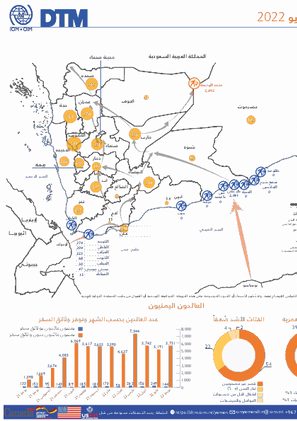
Contact
DTM Yemen, iomyemendtm@iom.int
Language
English
Location
Yemen
Period Covered
Jun 01 2022
Jun 30 2022
Activity
- Flow Monitoring
في يونيو 2022 ، سجلت مصفوفة تتبع النزوح (DTM) التابعة للمنظمة الدولية للهجرة في اليمن 3,174 مهاجرًا دخلوا اليمن ، مقارنة بـ 3,228 مهاجرًا في مايو 2022. في كل من شبوة ولحج ، سجلت مصفوفة تتبع النزوح انخفاضًا في عدد الوافدين منذ فبراير 2022 على الرغم من ملاحظة زيادة طفيفة في شبوة في يونيو مقارنة بشهر مايو. ويرتبط الانخفاض الإجمالي جزئياً باحوال الطقس الموسمية بالإضافة إلى زيادة الدوريات الحدودية في الجانب الجيبوتي ، وخاصة بالقرب من لحج ، مما يعني أن القوارب الأصغر التي يقل عدد المهاجرين فيها قد شقت طريقها إلى اليمن. يمكن أن تعزى الزيادة الطفيفة في شبوة إلى الحاجة الملحة لإرسال أكبر عدد ممكن من المهاجرين من بوساسو بالصومال إلى شبوة باليمن لأن موسم الرياح يقترب وسيكون من الصعب على المهاجرين السفر في تلك الفترة.
بالإضافة إلى ذلك ، سجلت مصفوفة تتبع النزوح في اليمن حوالي 5,895 يمني عادوا من المملكة العربية السعودية خلال شهر يونيو، مقارنة بـ 5,440 في مايو 2022. خلال الفترة بين 1 يناير و 30 يونيو 2022، وصل ما يقدر بـ 31,266 مهاجرًا و 35,285 يمنيًا عائداً إلى اليمن.
حيث مثل عدد المهاجرين من إثيوبيا88 % في المائة و 12 في المائة من الصوماليين. كانت غالبية المهاجرين من الذكور (63%) مع (21%) من النساء ، و ثمانية في المائة من الأولاد و ثمانية في المائة من الفتيات اللواتي كنا ايضاً من ضمن المسافرين.
خلال فترة التقرير في يونيو 2022، شوهد وصول 2,091 مهاجرا من الصومال وتم تسجيلهم في نقطة مراقبة التدفق في بئر علي في محافظة شبوة. بينما شهدت نقاط مراقبة التدفق بمديرية المضاربة والعارة بمحافظة لحج وصول عدد 1,083 مهاجرا وصلوا من جيبوتي , حيث تم تسجيل 374 في الكوحه ؛ وا 304 في الباطن ؛وا 225 في العزاف ؛ وا 68 في الكروب ؛وا 50 في الحجاف ؛ وا 47 في حسي عيسى ؛ وا 15 في المخاباه.
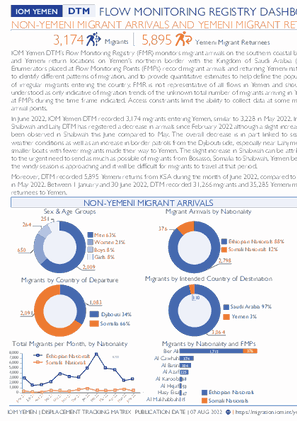
Contact
DTM Yemen, iomyemendtm@iom.int
Language
English
Location
Yemen
Period Covered
Jun 01 2022
Jun 30 2022
Activity
- Flow Monitoring
In June 2022, IOM Yemen DTM recorded 3,174 migrants entering Yemen, similar to 3,228 in May 2022. In both Shabwah and Lahj DTM has registered a decrease in arrivals since February 2022 although a slight increase has been observed in Shabwah this June compared to May. The overall decrease is in part linked to seasonal weather conditions as well as an increase in border patrols from the Djibouti side, especially near Lahj meaning smaller boats with fewer migrants made their way to Yemen. The slight increase in Shabwah can be attributed to the urgent need to send as much as possible of migrants from Bosasso, Somalia to Shabwah, Yemen because the windy season is approaching and it will be difficult for migrants to travel at that period.
Due to the deteriorating humanitarian crisis in Yemen and the challenges in moving towards KSA, many migrants opted to return to the Horn of Africa. Moreover, DTM recorded 5,895 Yemeni returns from KSA during the month of June 2022, compared to 5,440 in May 2022. Between 1 January and 30 June 2022, DTM recorded 31,266 migrants and 35,285 Yemeni migrant returnees to Yemen.
The migrant caseload was around 88 per cent Ethiopian nationals, and around 12 per cent Somali nationals. The migrants are predominantly male (63%), with (21%) women, eight per cent boys and eight per cent girls also among the travelers.
Through June’s reporting period, 2,091 migrants arrived from Somalia and were recorded at Ber Ali flow monitoring point in Shabwah governorate. In Lahj governorate, 1,083 migrants arrived from Djibouti, wherein 374 were recorded at Al Cawhah flow monitoring point (FMP), 304 at Al Batin FMP, 225 at Al Azaf FMP, 68 at Al Karoob FMP, 50 at Hasy Eisa FMP and 15 at Al Cawhah FMP.

Contact
Santo Miguel Roman saroman@iom.int
Language
English
Location
Burkina Faso
Period Covered
May 01 2022
May 31 2021
Activity
- Flow Monitoring
L’OIM, a travers l’outil de Suivi des flux de populations (Flow Monitoring) de la Matrice de suivi des déplacements (DTM), récolte des données à des points d’entrée, de sortie et de transit clés, afin de mieux comprendre les mouvements de populations à travers l’Afrique de l’Ouest et du Centre. Le suivi des flux de population est une activité qui permet de quantifier et de qualifier les flux et tendances de mobilités, les profils des migrants, et les expériences et routes migratoires. Au Burkina Faso, des points de suivi des flux de populations (FMP) ont été progressivement installés sur plusieurs lieux de transit importants à Dori/Seytenga en février 2018, à Kantchari en mars 2018, ainsi qu'à Faramana et Yendéré en avril 2018 pour faire le suivi des flux migratoires dans le pays.
Au Burkina Faso, le suivi des flux de population se fait au niveau des quatre FMP et vise à mettre en lumière les zones particulièrement sujettes aux migrations transfrontalières et intrarégionales.
Ce rapport présente les données recueillies aux FMP du Burkina Faso en mai 2022.
Contact
DTMAfghanistan@iom.int
Location
Afghanistan
Activity
- Mobility Tracking
- Site Assessment
- Baseline Assessment
Period Covered
Mar 01 2022 -Apr 30 2022
A baseline assessment is a sub-component of mobility tracking. It aims to collect data on IDP, migrant and returnee population presence in a defined administrative area of the country.
This dataset contains information by settlement. Settlement is the lowest unit of observation used in Afghanistan.
Population Groups
Survey Methodology
Unit of Analysis Or Observation
Type of Survey or Assessment
Keywords
Geographical Scope
Administrative boundaries with available data
The current dataset covers the following administrative boundaries
